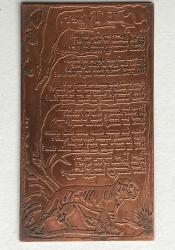William Blake Completes Apprenticeship and Starts Independent Career
In 1779 William Blake completed his apprenticeship and started an independent career as an engraver. In addition to working on his own artwork, he did comission work for other artists, much of it engraving. The conventional method of engraving at this time was copperplate engraving, a very long and tedious process that came about in the 15th century. It required many slow and careful hours of work because any mistakes would be impossible to correct without restarting the piece. Copperplate engraving uses an intaglio printing technique. Lines are carved into the plate and ink is placed into the grooves and then wiped away from the rest of the piece. The plate is then pressed into a humid sheet of paper using a printing press. Copperplate engraving was said to produce more exquisite images than woodcuts, though many famous engravers -- Blake included -- were masters of both techniques. For many of his most famous works, however, Blake used a method of printing that he invented called "illuminated printing," though it is known today as relief etching. This method involved painting the design on the copper plate backwards using an ink that was resistant to nitric acid. When the plate was put in the acid, it would etch away all of the unprotected metal and leave the design raised so that it could be easily printed.

